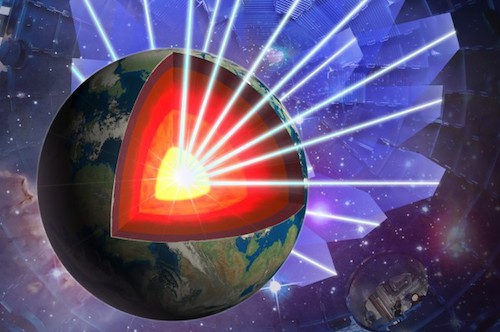Laser Compression of Iron Gives Insight into Cores of Large Rocky Exoplanets

The NIF lasers are focused onto a multistepped iron sample at the center of a 10-meter-diameter target chamber. These experiments measure the equation of state of iron under core conditions of large rocky exoplanets. (Image: LLNL)
Researchers from Lawrence Livermore National Laboratory (LLNL; Livermore, CA), Princeton University (Princeton, NJ), Johns Hopkins University (Baltimore, MD), and the University of Rochester (Rochester, NY) have provided the first experimentally based mass-radius relationship for a hypothetical pure iron planet at super-Earth core conditions.
This discovery can be used to evaluate plausible compositional space for large, rocky exoplanets, forming the basis of future planetary interior models, which in turn can be used to more accurately interpret observation data from the Kepler space mission and aid in identifying planets suitable for habitability.
Of the more than 4000 confirmed and candidate extrasolar planets, those that are one to four times the radius of the Earth are now known to be the most abundant. This size range, which spans between Earth and Neptune, is not represented in our own solar system, indicating that planets form over a wider range of physical conditions than previously thought.
As core pressures for even a 5×Earth-mass planet can reach as high as 2 million atmospheres, a fundamental requirement for constraining exoplanetary composition and interior structure is an accurate determination of the material properties at extreme pressures. Iron (Fe) is a cosmochemically abundant element and, as the dominant constituent of terrestrial planetary cores, is a key material for studying super-Earth interiors. A detailed understanding of the properties of iron at super-Earth conditions is an essential component of the team’s experiments.
Ramp compression
The researchers describe a new generation of high-power laser experiments, which use "ramp compression" techniques to provide the first absolute equation of state measurements of Fe at the extreme pressure and density conditions found within super-Earth cores. Such shock-free dynamic compression is uniquely suited for compressing matter with minimal heating to TPa pressures (1 TPa = 10 million atmospheres).
The experiments were conducted at the LLNL's National Ignition Facility (NIF). The NIF laser system can deliver up to 2 MJ of laser energy over 30 ns and provides the necessary laser power and control to ramp-compress materials to TPa pressures. The team’s experiments reached peak pressures of 1.4 TPa, four times higher pressure than previous static results, representing core conditions found with a 3-4×Earth mass planet.
The outcome was an experimental mass–radius relationship for a hypothetical pure iron planet, useful for models of large, rocky exoplanets.
Future experiments at NIF will extend the study of planetary materials to several TPa while combining nanosecond x-ray diffraction techniques to determine the crystal structure evolution with pressure.
